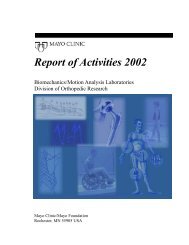Finding Optimal Cutpoints for Continuous ... - Research - Mayo Clinic
Finding Optimal Cutpoints for Continuous ... - Research - Mayo Clinic
Finding Optimal Cutpoints for Continuous ... - Research - Mayo Clinic
You also want an ePaper? Increase the reach of your titles
YUMPU automatically turns print PDFs into web optimized ePapers that Google loves.
The two-fold cross-validation technique provides a third method <strong>for</strong> determining the<br />
statistical significance of a cutpoint model [3, 7]. The steps involved in the technique are as<br />
follows:<br />
(1) Randomly split all observations into two data sets of approximately equal size (call<br />
these Set I and Set II).<br />
(2) Using Set I, find the cutpoint with the minimum p-value (C1).<br />
(3) Using Set II, find the cutpoint with the minimum p-value (C2).<br />
(4) Using C1, group patients in Set II into High (above C1, H) and Low (below C1, L).<br />
(5) Using C2, group patients in Set I into High (above C2, H) and Low (below C2, L).<br />
(6) Use the High and Low classifications to calculate the two-sample test statistic.<br />
In simulation studies, Type I error rates from two-fold cross-validation were found to be<br />
approximately correct [3]. Two-fold cross-validation has the additional benefit of providing<br />
approximately unbiased estimates of effect size. Finally, the split sample approach can also be<br />
used to calculate p-values that are not affected by the multiple testing procedures. With this<br />
approach a data set is divided into a training set and a validation set. An optimal cutpoint is<br />
determined from the training set, and its significance and effect size determined from the<br />
validation set. While able to produce approximately correct p-values and effect sizes, this<br />
method does not use the entire data set in estimating an optimal cutpoint and often needs a large<br />
data set in which to split the data [3, 7]. In this report, we do not pursue the two fold cross<br />
validation and the split sample approaches.<br />
2c. Summary of strategy and SAS Macro Content<br />
In this Technical Report two SAS macros, %cutpoint and %findcut, are introduced which<br />
execute the a<strong>for</strong>ementioned techniques <strong>for</strong> binary and time to event outcomes respectively. The<br />
7




